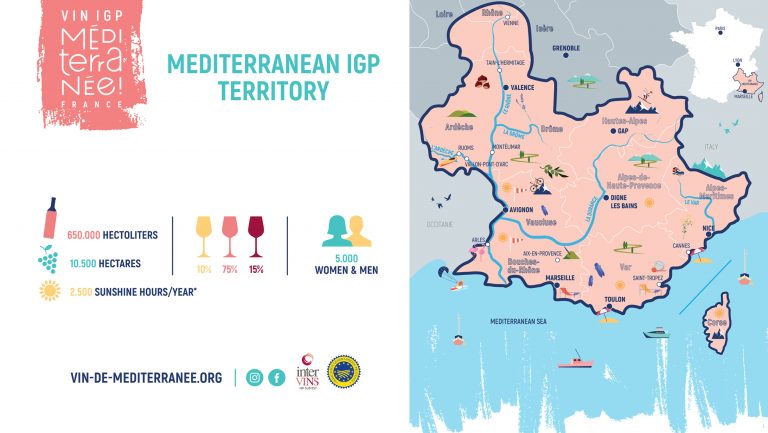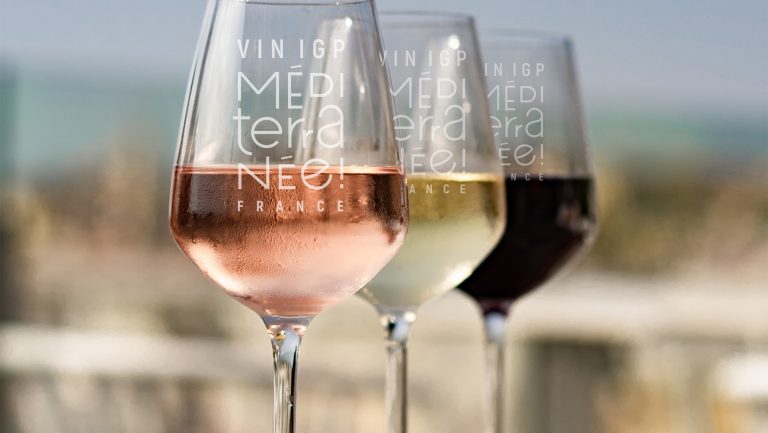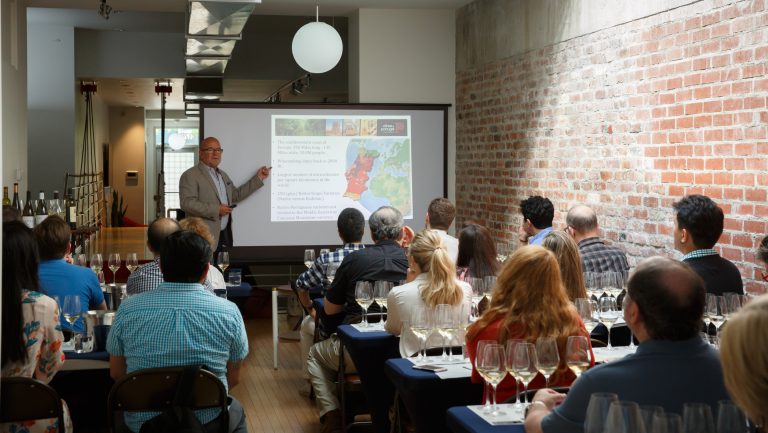This advertising content was produced in collaboration with our partner, Intervins Sud-Est.
If Provence rosé is the popular, overachieving sibling, IGP Méditerranée wine is the creative and uninhibited cousin: expressive, authentic, flaunting individuality while conforming just enough to fit within the confines of family expectations. This fashionable category encourages creativity and ingenuity among producers, while eliciting romantic daydreams of basking in the joie de vivre of the South of France.
IGP Méditerranée’s sprawling area includes 10,500 hectares under vine and encompasses a rich and vast territory, including 10 départements: Corse-du-Sud, Haute-Corse, Ardèche, Drôme, Hautes-Alpes, Vaucluse, Alpes-de-Haute-Provence, Alpes-Maritime, Bouches-du-Rhône, and Var. The terroir is enviable, with 2,500 hours of sunshine every year, rolling hillsides, well-draining calcareous and limestone soils near the Mediterranean Sea enriched with alluvium along the Rhone, and fresh salt-tinged sea breezes and Le Mistral gusts that keep vines dry.
“IGP Méditerranée is surrounded by some of the most famous rosé appellations on the planet,” says Matthew Kaner, a sommelier, wine consultant, and the founder of Will Travel for Wine Consulting. “The vineyard land is often alpine with good exposure, and the elevation allows for diurnal shifts in temperature to preserve freshness in the wines.”

Don’t miss the latest drinks industry news and insights. Sign up for our award-winning newsletters and get insider intel, resources, and trends delivered to your inbox every week.
The savvy Greeks who introduced winemaking here in 600 B.C. knew its potential. The area became an IGP in 2009—the largest in southeast France and one of 75 in the country. Today there are 650,000 hectoliters of wine made annually, predominantly blends, with rosé accounting for 75 percent of production, along with 15 percent red and 10 percent white.
For both buyers and consumers, the wines of the IGP Méditerranée offer enormous value—and these are a few of the ways they boost the desirability of any wine list.
1. They Offer Exciting Diversity Thanks to Looser Restrictions
Much like Cézanne and his Impressionist cohorts who flocked to this area to capture on canvas its intense natural light, IGP Méditerranée winemakers use broad strokes to impart a signature stamp. Strict regulations on production techniques, vineyard locations and yields, and permitted varieties that are the hallmark of regions like Burgundy and Bordeaux just don’t apply here.
The IGP specifications do not take into account the villages and the vineyards, but highlight the grape varieties. IGP Méditerranée winegrowers can therefore let their creativity express themselves by offering sunny, generous, and gourmet wines. Their unique expertise in blending marvelously reflects the multiple expressions of this territory thanks to an incredible palette of grape varieties.
Red grapes like Merlot, Syrah, and Grenache are joined by white varieties like Chardonnay, Viognier, Muscat, and Vermentino, locally called Rolle. New varieties have also emerged including Chasan, a cross between Listan and Chardonnay, and Marselan, a cross between Cabernet Sauvignon and Grenache Noir.
Expressions vary, but “reds tend towards medium to full-bodied with lovely berry notes intermingled with herbaceous notes of rosemary, thyme, and lavender,” says Mika Carlin, the cofounder of Irregardless, a wine bistro in Washington, D.C. “Whites maintain a base minerality and fullness of body due to the warmth and sun that the grapes receive in this region.”
As in Provence, pink wines dominate, vinified both in that benchmark pale salmon-hued style with whiffs of watermelon, minerality, and juicy acidity, as well as a more intense, fuller-bodied style that shows cherry, strawberry, and a touch of irresistible spice. It’s a great example of how IGP Méditerranée wines never fail to surprise.

2. A Connection to the Coveted Mediterranean Lifestyle
Southern France is legendary for its abundant sunshine, sweeping panoramas topped by pure blue sky, and the heady scent of lavender fields in bloom. Transcending the stunning aesthetics is a belief that those who call the region home enjoy a balanced, relaxed quality of life, with ample time to linger with family and friends over casual, convivial gatherings and partake in leisure activities. IGP Méditerranée wines help consumers around the globe make the connection to that charming Mediterranean lifestyle—and its accompanying healthful Mediterranean diet of olive oil, fresh vegetables, fish, whole grains, and herbs.
That association extends to an ubiquitous feature of the landscape whose aromas find their way into the glass. Garrigue, the underlying shrubs that dot the areas in and around the vineyards, either growing wildly or introduced as windbreaks to counter Le Mistral, often end up intermingling with grapes on the vine.
“The bouquet of aromas of those wines is similar to opening a jar of Herbs de Provence: savory, herbaceous, and distinctly Mediterranean,” Carlin says. “Garrigue is a beautiful and classic example of the nearly inescapable effect of terroir in this IGP.”
IGP Méditerranée wines are indeed transportive; sipping them can take you to a busting cafe in Marseille, a family lunch en plein air at a sprawling countryside property outside Avignon or on a picnic blanket spread out next to a garden of aromatic verveine.
3. Appealing to a Wide Swath of Wine Drinkers and Befitting Many Occasions and Food Pairings
The freedom of expression winemakers are afforded here extends to the packaging; bottles are often labeled with the included grapes rather than location, making them more consumer-friendly. This is a consideration for anyone new to wine, but it can be especially impactful in reaching young consumers curious to discover new wines but intimidated when they are unsure what’s actually inside the bottle.
Millennials and Gen Z wine drinkers are more open to trying new wines, especially from trending regions, with less-expected grapes or blends and modern techniques. To that end, winemakers here are experimenting with vineyard practices including planting in cool and higher-altitude sites and cellar practices including fermentation in concrete eggs.
IGP Méditerranée wines are trend-forward yet accessible, effortlessly food-friendly, and fitting for casual events or formal dinners, and everything in-between. Rosé is no longer reserved for the summer months but quaffable year-round, paired with friends on the patio or gatherings around the table. In the warmer months, these bottles are well-matched with heirloom tomato, watermelon, and feta salad, saucisson sec and other charcuterie, and grilled chicken sausage.
When the weather turns chilly, crisp Vermentino can cut through rich pasta and cream-based dishes, while red blends work with braised and roasted meats and stews, and provençal specialties like bouillabaisse, ratatouille, and daube. Their dried spice notes lend an herbaceousness that, along with balanced tannins and fruit, make them perfect with spicier fare including southeast Asian cuisine.
As exports of IGP Méditerranée wines to the U.S. grew 30 percent from 2020 to 2021, it’s clear that this up-and-coming category is resonating with American wine lovers. As Kaner puts it, “The food, happiness, landscape, and history lend to an unique experience filled with education and pleasure—exactly how I feel each time I open a bottle of wine from IGP Méditerranée.”

Dispatch
Sign up for our award-winning newsletter
Don’t miss the latest drinks industry news and insights—delivered to your inbox every week.









